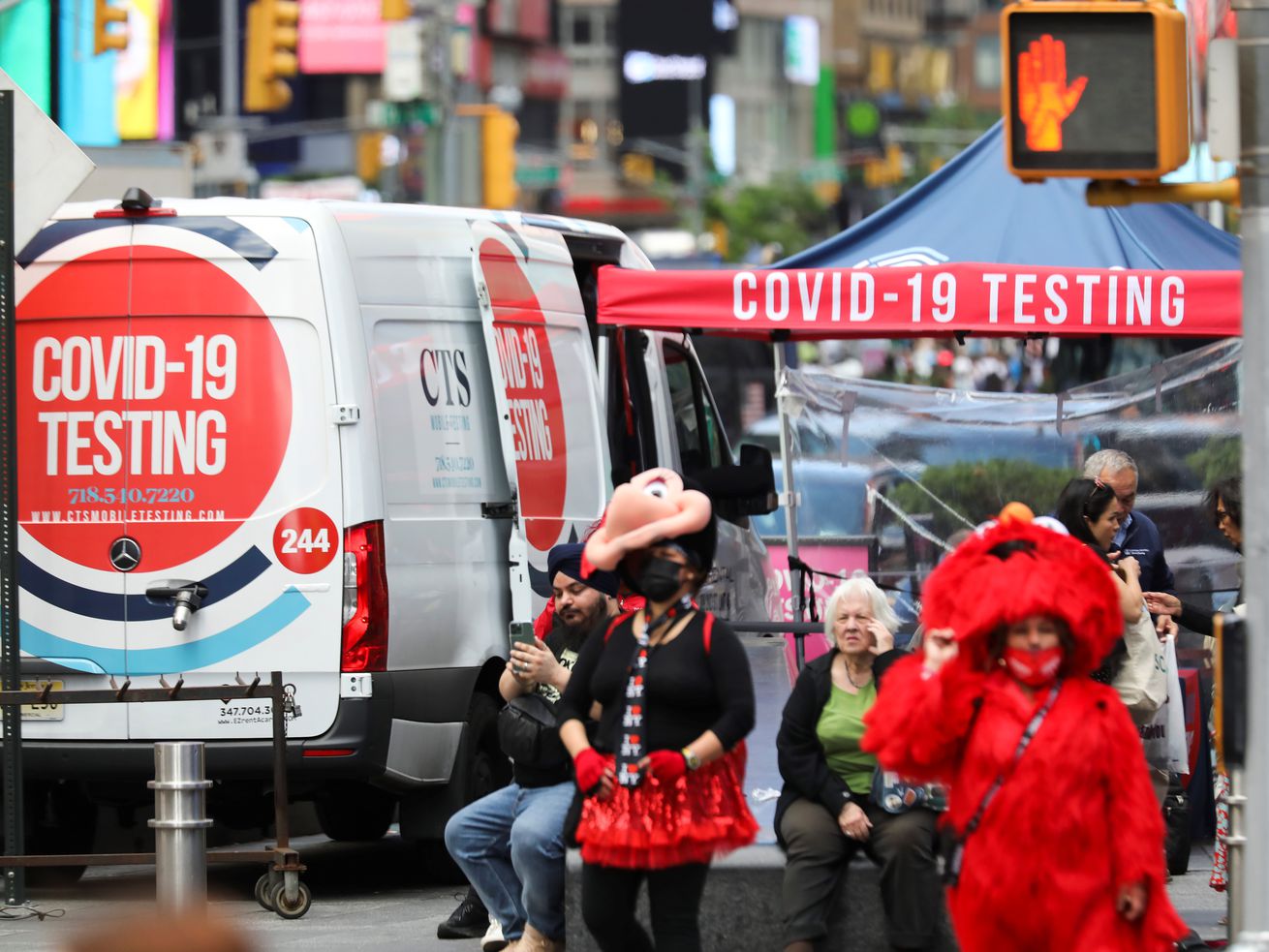Covid-19 isn’t going anywhere it seems, yet conflicting public health messaging and a lack of funds may only prolong the crisis.
Covid-19 — and the resulting pandemic associated with the virus — continues to threaten the world. In the US, a majority of the population is experiencing low Covid-19 community levels, according to the Centers for Disease Control and Prevention (CDC). Yet roughly a third of Americans are still living in areas with high risks, primarily in the Northeast and Midwest.
As we enter our third summer since the Covid-19 outbreak began, public health experts are warning of another likely wave of infections. But as public concerns over the pandemic begin to wane, public health messaging around Covid-19 may become more challenging.
On Thursday, the CDC recommended those living in communities with high levels of infection wear face masks indoors in public settings, even though the federal mask mandate is no longer in effect after it was overturned by a federal judge.
“We urge local leaders to encourage the use of prevention strategies like masking in public indoor settings, and increasing access to testing and treatment for individuals,” CDC director Dr. Rochelle Walensky told the New York Times.
Hospital data remains a primary metric in how experts are tracking trends in the pandemic. As of early May, Covid-19 hospitalizations were up by 22.4%, with about 3,000 people admitted with Covid-19 per day, according to the CDC. Experts believe those numbers will only trend upward in the months to come, underlining the need for strong public health measures.
Public health messaging around Covid-19 must continue
/cdn.vox-cdn.com/uploads/chorus_asset/file/23580916/1237665583.jpg)
Kent Nishimura / Los Angeles Times via Getty Images
With the politicization of Covid-19, public health messaging around the pandemic in the US has faced an uphill battle — and it shows. Beyond the recent hikes in hospitalizations, as of May 20, only 66.5% of the US population had been fully vaccinated — lagging behind other wealthy nations like France, Japan, and the UK — while just 46.4% had received a booster, according to CDC data.
But in a country where public health recommendations like getting vaccinated and wearing masks have become the cruxes of political debates, getting citizens on board with public health measures is easier said than done.
Research shows that masks, if used correctly, can be a valuable tool for reducing the spread of the virus. But the CDC’s mask recommendation for people living in areas with high risks of Covid-19 this week was met with mixed responses online. Some have criticized the agency’s inconsistency in its masking policy, while others tried to paint the CDC’s motives as political, pointing to the upcoming midterm elections.
In April, US District Judge Kathryn Kimball Mizelle ruled to overturn the CDC’s mask mandate for public transit. In her ruling, Mizelle — a Trump nominee who was rated “not qualified” for that position by the American Bar Association — contended that the federal public health agency had overstepped its authority in enacting the public health mandate.
Michael Osterholm, director of the Center for Infectious Disease Research and Policy at the University of Minnesota, says a combination of confusing guidelines from public officials and a lack of careful reporting by the media have led to the politicization of public health measures.
“The U.S. public is done with the pandemic even though the virus is not done with us, and we have to recognize that in public health,” Osterholm said in a televised interview with ABC News following the ruling. “What has happened is this has become really a philosophical and political issue, not a science issue.”
According to Dr. Renuga Vivekanandan, the division chief for infectious disease at CHI Health and Creighton University, strong public health measures and messaging are crucial in preventing the spread of the coronavirus. “It’s very important to have public health measures to try to blunt the Covid-19 or any other type of infection rate,” Dr. Vivekanandan told Vox. “We have to have a uniform message [and] make sure we give the right information to our community.”
Vivekanandan, whose work focuses on preventing the spread of infections in public settings, says she is focused on providing patients with the right information regarding proper pandemic mitigation tools, such as vaccinations, boosters, and masking in public, even though she still encounters people unwilling to get vaccinated.
“There are some individuals who still want to think about it or who still do not want to receive the vaccine, but I think that’s an individual choice,” said Vivekanandan. “But as public health [officials], we’re just going to continue to stay with that messaging and show what works and what doesn’t.” Relatively low vaccinations, as well as booster rates, are other public health mitigation tools that would benefit from stronger public health messaging, she said.
Building public health infrastructure and stabilizing funding is key
Despite these concerns around the erosion of public trust in public health, experts are undeterred and have proposed ways to strengthen the country’s public health measures. Doubts about the authority that government health entities can wield when it comes to enacting public health measures in times of crisis only fuel distrust and conspiracies around government health guidelines. Rebuilding public trust is key and that starts by establishing credibility through clearer government structures and providing a uniform message around Covid-19 public safety protocols.
A 2021 report from the think tank Bipartisan Policy Center suggested 10 broad recommendations to prepare the US for the next pandemic cycle, including the need to clarify federal responsibilities during a pandemic and create a national board on pandemic preparedness, which would be tasked with establishing a standard of benchmarks to evaluate the country’s preparedness.
Beyond rebuilding public trust, building out public health infrastructure and stabilizing funding are key ways to address the current pandemic and better prepare for what may lie in store in the future. It’s critical that the US continues to respond, as Covid-19 is certainly not going away.
“The pandemic is going to be a turning point,” said Tom Frieden, a former director of the CDC, and a member of the American Public Health Association. “Whether it’s toward a healthier society or one more resistant to collective action to protect one another, time will tell.”
Weak public health messaging may also have wider implications when it comes to fighting off the next wave of Covid-19 infections. Congress has been in deadlock over President Joe Biden’s Covid-19 relief proposal — which was slashed from $22 billion to $15 billion — since early March. A seeming lack of urgency in dealing with the pandemic could affect the ease of accessing more funding as well. White House pandemic coordinator Dr. Ashish Jha warned that drained funds, which would cover the country’s purchase of the next generation of Covid-19 vaccines, could lead to issues in the fall when the US is expected to see more waves of infection.
In a 2021 report by Trust for America’s Health, which issues annual findings on the country’s readiness in facing health crises, the Trust recommended addressing the steady decline in public health funding through the creation of a mandatory $4.5 billion-per-year public health infrastructure fund. Legislation to establish a similar “off-limits” fund dedicated to public health infrastructure development was introduced in Congress by Democratic Sen. Patty Murray last year.
“While the vaccines have given us a way to get through COVID, we also have to learn from this pandemic and make sure we are better prepared for the next public health emergency. That means finally making — and maintaining — the kind of bold investments in public health I have been pushing for, for years,” Murray said of the Public Health Infrastructure Saves Lives Act.
Until a more robust public health infrastructure is implemented, the onus of keeping the next Covid-19 wave at bay lies with each community member.
“What I’ve thought about during the pandemic, it’s not ‘I’ it’s ‘us,’” Vivekanandan said. “I think the public health community have been doing their very best… communicating that public health message about how we can all work together to make sure every time we have a wave [we] bring the wave down and protect each other.
Author: Natasha Ishak
Read More



